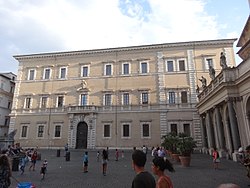|
Palazzo San Callisto
In the courtyard of the palace is the well where, according to tradition, Pope Callixtus I was martyred in the year 222.[2] HistoryThe palace was originally the residence of the titular cardinals of the Basilica of Santa Maria in Trastevere and was renovated in the 16th century under Cardinal Giovanni Morone by architect Orazio Torriani. Pope Paul V granted the palace to the monks of the Order of St. Benedict who had to leave their previous monastery due to an extension of the Quirinal Palace. The building took the name of the small adjacent church of San Callisto. Between 1610 and 1618 both the church and the convent were renovated. [3] In 1936 during the pontificate of Pope Pius XI the architect Giuseppe Momo, known for the double helix staircase of the Vatican Museums, designed the construction of a new wing. [2] One facade of the palace faces the celebrated Fountain in Piazza Santa Maria in Trastevere. In 1990, the Palazzo was placed on the UNESCO World Heritage Register.[4] Current UseIt currently serves as home to:
 See also
References
|
||||||||||||||||||||||||||||

